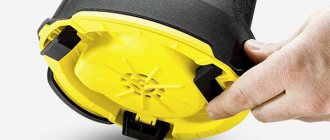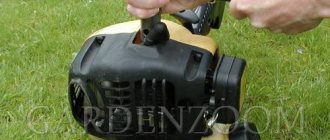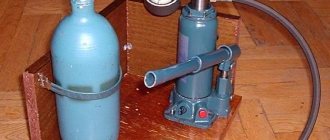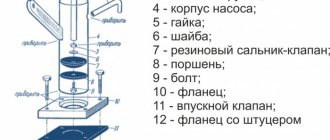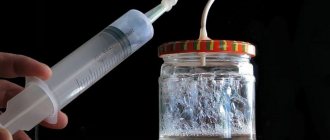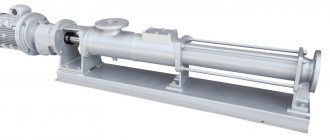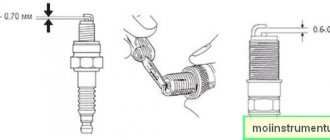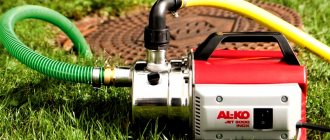Let's look at how to repair drainage pumps with your own hands, without the involvement of professional specialists. Drainage pumps are a special type of equipment designed for pumping water. Outwardly, they are similar to conventional water pumps, however, they are adapted to work in much more difficult conditions. They can be used for pumping water from wells saturated with mechanical inclusions - a suspension of sand, clay, etc. But, despite all its wear resistance and unpretentiousness, drainage equipment can also fail from time to time.
Do-it-yourself drainage pump repair
The main advantage of drainage pumps is the simplicity of their design.
They consist of three main structural parts:
- Electric motor - rotates the shaft and blades, creating water pressure.
- A float switch designed to automatically turn off the device when draining the well.
- A pumping unit consisting of a shaft with blades strung on it.
All of the listed components of the unit, with the exception of the float, are located in a durable metal or polymer housing. The float can be either built into the body or remote. The most common malfunctions of pumping equipment intended for drainage work should be recognized:
- Combustion of the electric motor winding. Possible during long-term non-stop use of the device, or due to dry operation.
- Wear of mechanical parts and components.
- Clogging of filters and pump cavities with large mechanical fragments, sand or silt.
Diagnostics
You can repair the drainage pump yourself in situations where the breakdown is not so significant. To do this, you will need to diagnose the operation of the device, identify the malfunction and try to eliminate it. For example, it will not be difficult to replace a worn or broken part, or clean the filters. It is also possible to carry out simple electrical repairs at home - replacing a broken electrical cable or capacitor.
But if a crack appears in the body of the device, the winding of the electric motor burns out, or the valve stops working, it is better to contact a specialized workshop or purchase a new pump.
A break in the power cable can be easily repaired if it breaks near the plug. It will be more difficult to close the gap on submersible models of the drainage pump, in an underwater location. Here, due to the likelihood of a short circuit, you cannot connect the break using simple twisting.
You will need to cut the cord at the fracture site and reattach it to the engine. To do this, you will have to remove the cover and remove the cut off remainder of the cable. Instead, using a tension element, we attach a long cord with a plug, after which we put the cover in place, carefully and thoroughly tighten the fastening bolts.
The pump works but does not pump water
In the case when the electrical part of the pump, judging by the sound, is working properly, but water is not supplied to the surface, or its pressure is significantly weaker than before.
There are several reasons for this:
- The water supply line - hose or pipe - is clogged. You will need to disconnect the hose supplying water upward from the pipe and clean them of dirt. If the new pump cannot create the required pressure, it is likely that the length of the water pipes exceeds the technically recommended values, and the device simply cannot create the required pressure. A similar reason lies in the too small diameter of the pipeline. To increase the pressure, you will need to reduce the length of the line, or increase the diameter of the pipes (hose).
- Wear of the working mechanism – the water impeller. Due to constant contact with mechanical debris contained in the water, its blades may wear out, bend, or break off over time. This problem can be corrected only by replacing the part with a new one.
- Difficulties in supplying water may arise due to the pump or its suction tube being too low. At the bottom of the well there is always an increased concentration of silt, suspended sand and clay. Such a suspension has difficulty passing through the filters, and the pressure drops. To solve this problem, you should raise the pump higher from the bottom of the well.
- The filters are clogged. You can wash them with a powerful stream of running water. In particularly “severe” cases, you will have to disassemble the case and clean the mechanism manually.
- When the power of the electric motor decreases, the housing or water hoses may have depressurized, the bearings have failed, or there is insufficient voltage in the power supply network.
- Malfunctions in the electrical part can be determined by “ringing” the wiring of the device using a special device - an ohmmeter. It will show a broken wiring or a burnt out winding of the electric motor.
To accurately determine the malfunction and repair the drainage pump yourself, you will have to disassemble it. This should be done carefully so as not to damage the parts and components of the device.
Common problems
Nature of the failure and cause of its occurrence:
- Doesn't buzz and doesn't work. The drainer is lowered into the water, the float has surfaced and is on the surface, the cable is connected to the circuit, but the engine does not work, there is no vibration. The cause of the breakdown is a discrepancy between the declared motor power and the electrical network to which the device is connected. Carefully read the characteristics of the pump, its power and efficiency. The pump is not lowered deep enough into the water and the float does not work. Remove the device and, lifting the pillow up, turn it back on.
- It works, but doesn't download . The engine is on, but no water comes to the surface. There are several reasons for this. The protective mesh blocking debris and stones at the bottom of the case is clogged. Raise the device and clean the filter. The thick fraction got into the discharge hose and a blockage occurred. If such a breakdown occurs, it may be knocked out of the base of the pump; if this does not happen, you need to disconnect it yourself and wash it. The impeller is broken. Its augers may break or the bearing may collapse; this can be found out by disassembling the pump.
- Vibrates and overheats. The electric motor braid was broken, water got into the engine compartment, and the shaft bearing was destroyed. The unit vibrates and heats up, while the water flows in jerks or stops altogether. We urgently turn off the power to the equipment and pull it to the surface. The cause of the breakdown is hidden inside. For diagnostics it is necessary to disassemble the case. Several impeller blades are broken. The rotation occurs with an eccentric and hits the body on one side.
- Low pressure with a properly running engine is a consequence of a breakdown of the mechanical part of the pump. Impeller or bearing, clogged discharge hose or suction filter. It can be eliminated by simply washing it in clean water or replacing mechanical parts.
- When the unit is connected to the network, the automatic switch is activated . The fuse cuts off the network if a short circuit occurs. Check all electronic parts of the pump. Go through the cable with a tester and find out where the short circuit occurred - replace it. The motor's copper braiding is also at risk if the unit is run dry. The braid can be replaced or a new engine installed only in a repair shop.
- The device works, but turns itself off. Connected to the network and working, pumping water properly. Suddenly it turns off on its own. The reason is a mismatch between the power of the motor and the electrical network. Voltage surges can also affect the smooth operation of the unit. The solution is simple - study the instructions and characteristics of the pump in detail, install a voltage stabilizer.
Tip: to pump out all the liquid completely, the float is tied to a cable in a vertical position and lowered into the water. Adjust the switching on and off of the device by unplugging the plug from the socket.
How to disassemble a drain pump
The analysis is carried out in several successive stages:
- Turn the pump over with the filters facing up and carefully clamp the housing in a vice. Remove the filter mesh, then the protective casing, under which the impeller is installed. For different models, it is mounted with bolts, clips, or screwed in with a thread.
- Unscrew the fixing nut holding the impeller to the rod. These nuts have a left-hand thread, so they are unscrewed by turning them clockwise. We remove the impeller, and if it is worn out, replace it with a new one.
- When the impeller is intact, disassembly should continue until the cause of the malfunction is identified. We unscrew the connecting bolts on the body, as a result of which it is divided into two components connected to each other by a train of multi-colored wires. If you need to disconnect them, you should first photograph their location.
- To separate the electric motor from the housing, you should lightly tap the rod with a hammer, since it is pressed into the housing very tightly. After removing the motor from the housing, the electrical part of the pumping equipment is diagnosed.
How to disassemble a float
Sometimes the reason that the pump does not want to work lies in a malfunction of the float mechanism. It is intended to protect the device from dry operation. To repair a drainage pump with a float, you will need to disassemble this device and inspect it from the inside. To open the float, unscrew the connecting bolts on its body, then pry off the connecting seam with a screwdriver. Inside there is a freely rolling ball, the movement of which turns on/off the power supply.
Read also: Voltmeter operating instructions
It happens that the ball stops spontaneously, blocking the engine from starting. Sticking can also be caused by the float body losing its seal, as a result of which the ball rusts or becomes overgrown with mineral deposits. To correct the situation, you need to clean it and properly seal the seams.
Useful video
Very detailed analysis:
Opening the Gilex float:
Let's look at how to repair drainage pumps with your own hands, without the involvement of professional specialists. Drainage pumps are a special type of equipment designed for pumping water. Outwardly, they are similar to conventional water pumps, however, they are adapted to work in much more difficult conditions. They can be used for pumping water from wells saturated with mechanical inclusions - a suspension of sand, clay, etc. But, despite all its wear resistance and unpretentiousness, drainage equipment can also fail from time to time.
How to turn off the float on a sump pump
In some situations, a complete replacement of the float device will be required. In this case, you will need to first disconnect it from the pump. The float is part of the electrical system of the pumping equipment, and is equipped with a lever with a circuit breaker. To turn it off, you will need to disconnect the wires and replace the faulty unit.
If a spare float is not available and the pump needs to be restored to service immediately, as a temporary measure, you can connect the wires leading to the float directly, without a disconnector. In this case, it is necessary to ensure that the junction of the wires is raised above the water level. Otherwise, there is a high probability of a short circuit. You will have to monitor the operation of the drainage pump with the float turned off “in manual mode”, otherwise it may break down when the pumped water level drops.
The operation of pumps is controlled using various devices, and one of the most common is a water level float switch. It can simultaneously perform the task of a water level sensor and be an actuator for controlling the pump. Floats for the pump are placed in containers.
One tank can accommodate several such switches, and they can solve different problems:
- Monitor the operation of the main pump.
- Serve as an overflow sensor.
- Ensure the operation of the auxiliary pump.
- Serve as an emergency level sensor.
With the help of such devices, the pumping apparatus is protected from the “dry running” mode. When filling different tanks, this element protects them from overflowing. Float switches for pumps come in light and heavy sizes. The former are more often used in drainage and water supply systems; the second - in drainage, rain and fecal wastewater. In stores, devices are sold with a cable length of 2, 3, 5, 10 m.
Criterias of choice
To choose a high-quality drainage pump that will meet your requirements and can do its job effectively, you need to carefully consider the choice of equipment.
Consider the following nuances:
- You shouldn’t chase too much power; it will affect the tool’s parameters, power consumption, and rapid heating of the equipment. As a rule, pumps of this class are designed for a regular 220 volt network, and the power starts from 350 to 400 W. Three-phase models are used very rarely by private individuals.
- It is especially important to take into account the coefficient of liquid pressure created at the outlet. It is measured in meters of water, technical atmospheres or bars. The pressure must be sufficient not only to raise the water, but also to overcome the hydraulic resistance of the horizontal elements of the pipe.
- Be sure to know the maximum depth to which the equipment can be lowered.
- The higher the productivity, the higher the liquid pumping speed.
- Please note that some pumps are not capable of handling large solid deposits. Choose a knife rather than a cutting edge.
- Pressure and immersion depth - the height of the pumped liquid rises depends on these indicators.
- It is worth studying carefully the operating features - how to care for the equipment, how to change its elements and repair it.
As a rule, for the production of modern drainage pumps, cast iron and stainless steel are used together with other materials that will be needed to assemble the equipment body and other components:
- Stainless steel is a high-quality durable material that will last for many years;
- cast iron - highly durable, but weighs a lot and is expensive;
- plastic is a budget option that will last a relatively short time.
Equipment with a plastic body and a steel wheel is popular. This model ideally combines affordable price and high quality. Not long ago, such models with polymer working blades appeared on the market; they are cheaper than their technologically advanced counterparts. They are characterized by a long service life, durability and reliability.
Device design
The floating plastic switch housing contains an electrical switch and a lever that moves the switch contacts. There is also a steel ball that adjusts the position of the lever when the float position changes. of three wires is connected to the switch , the first of which is common, and the rest are connected to the normally closed and open contact of the device.
The circuit is completed by the black and blue wires when the float is in the down position. When you move it to the top position, the brown and black wires become the closing contacts. The wire that does not provide connection to the device must be insulated.
It is important that the supply cable has moisture-proof properties; the plastic box must be sealed. The cable outlet is sealed using a mechanical seal, and it also has a special device that eliminates mechanical stress in the cable. The insulated cable gland cavity contains a polymer resin that prevents water from entering.
The chemical properties and heat resistance of the housing and cable sheath, made using thermoplastic rubber, determine the switch’s ability to withstand interaction with the following aggressive substances:
- uric acid;
- alcohols;
- fecal water;
- gasoline;
- other things.
Due to the lack of pores on plastic cases, dirt appears on them. Because of this, sand, paper and other solids slide off, and the float remains buoyant.
Characteristics of the water level control sensor:
- Maximum switching current, A;
- Mains voltage, V - 220±10%;
- 10A - for active loads (starters, lamps, switches, heating elements, etc.);
- 8A - for reactive load (compressors, pumps, fans, etc.);
- Operating temperature range: 0−60°C;
- Protection: IP 68.
Advantages of the device
Among the advantages of a float switch, the first thing to highlight is that this device can serve as a regular sensor for determining the water level in a tank. It performs this task regardless of the purpose of using the container and its volume. This device will make the operation of the pump more convenient and simplify control of the functions of domestic and industrial water supply systems. Sometimes it can be used to successfully drain fluid.
The switch can be an element as part of the equipment during the construction of sewer communications. Simplicity and efficiency have ensured its widespread use in a variety of systems where it is necessary to control water levels. The ability to protect pumping systems in dry running mode is not the only advantage of the devices. With their help, you can prevent situations where water overflows in containers.
Where are drainers used?
There are 2 types of drains: surface and submersible.
Surface grades are used for filling or draining small containers, such as swimming pools. Submersible - designed for draining large areas, for example, sewers, flooded areas, huge tanks of water. The primary purpose of drainage pumps is drainage, despite the standard separation. The brand and type of device are selected based on the depth of the container and the contamination of the liquid.
Float switch installation
Devices can be installed in different ways. Before installation, you should make sure that the rated current required to operate the pump is less than the maximum permissible value given in the technical characteristics of this type of float. Among the known installation methods, the simplest is to place it in a tank, which involves the use of a device with a cable and a special sinker supplied with the device.
With this installation, the sinker is fixed on the cable, and then the length of the free-running arm is experimentally calculated. Using a latch, the sinker is secured to the cable, and then the cable is firmly fixed to the outside of the tank. The switch is then connected to the pump, and the device can be used for its intended purpose.
The float mounting option, which involves the use of a supply cable, can only be used when there is no risk of the main device getting caught or hanging in the tank itself and when there is only one float in it.
Sometimes several floats are installed. They are mounted on a rod, the role of which is often played by fragments of a plastic pipe, which is firmly fixed in the tank. Then floats are installed on the pipe, which must be correctly positioned, adjusted, and spaced along the length of the rod so as not to create difficulties for work.
The cables coming from the floats are connected to the rod using clamps. When choosing the number of float switches, pay attention to the number of pumps or the type and number of safety devices and control panels. Sometimes the problem of ensuring the operation of switches can be solved by using several rods. When determining installation schemes, their quantities and locations, each time take into account the features of the place of their installation or check with the project.
Read also: Patterns for iron gates
Main types of home appliances
The choice of a car pump always depends on its purpose. Namely: for what needs is it needed? The device can be used in everyday life for completely different purposes. For example, for a heating system, as a rule, a circulator is suitable; even a small, low-power device can cope with watering. There are also universal units that can cope with different tasks.
Before repairing a water pump, it is worth studying the advice of professionals.
Today on the market you can find a huge selection of household water pumps. They all have their own individual design, advantages and purpose.
Types of water pumps:
- Submersible. Such equipment only works when it is completely or partially immersed in liquid. Deep well immersion devices are usually made of high-quality stainless steel or polymer.
- Drainage structures. Their purpose is to pump water from a number of different places (swimming pools, basements).
- Superficial. Garden devices of this type are very popular, suitable for pumping drinking water.
- The most common pumps are centrifugal ones. They are installed on heating systems.
- Vibrating. Serve for pumping liquid.
All these pumps are of an electric type, booster in nature, and are high-pressure apparatus. There are also manual devices that operate from the effort of one person.
Principle of operation
Depending on the operation scheme of the float switch, the operating principle of the device also changes.
Water supply system, filling and emptying the tank . When the float operates according to this scheme, at the moment of ascent it de-energizes the pump that supplies water to the tank. When the float is on the surface, it gives a signal to turn on the automatic water supply station. The station can only be turned off when the device is immersed to the bottom when the container is empty.
Sewage system . The fecal pumping equipment is switched on when the main control device is raised. The pumping unit turns on when it sinks to the bottom. One float is capable of servicing two pumps at the same time: the first can supply water to the container if the float is in its lower position, the second pump is inactive at this time. When the float is at the top, the second pump is turned on, pumping out water. During this time the feed pump is inactive. This scheme is quite effective, as it eliminates problems with the regular delivery of water when filling the container.
Next step
You have checked the device for contamination and the electrical system, so why is the pump still not pumping water? Now inspect and thoroughly check the device itself. The pump has a filter device that may become clogged. In this case, clean it or replace it. This clogging problem can also occur with the check valve of the pumping station.
If everything is in order, then a more unfavorable option comes next. If the pump suddenly worked while there was no liquid in the tank, then the sensor inside the device could simply burn out due to overheating. In this case, you can’t do anything with your own hands. It is not even recommended to go to a specialist, because the water pump will no longer show as reliable a result as in the old days.
Operation, repair, maintenance
Compliance with the rules for operating floats will ensure their long-term operation. When the float is included in the water supply and sanitation system, you should not waste time on its maintenance. If the device controls the operation of sewer or fecal pits, it is recommended to clean the float and pump from contaminants at least once a month with a stream of water supplied under pressure. This will prevent the float from sticking or sticking to the discharge pipe or pump. A broken float switch is replaced, and the replacement is carried out by specialists from service centers.
When it is necessary to provide drinking water or remove contaminated wastewater, special devices are used together with pumps, in particular, a float switch. Since the device prevents dry-running, the service life of the pump is increased. A lot of energy is also saved, because, thanks to the float switch, the pump is activated only when necessary.
The float switch for electric pumps is an element of the general system of the pumping station and regulates the water level in the tank. They are also the most important protection against dry running of a pump with a float, which will increase the service life of the device.
Switches help reduce clogging due to sand getting into the system. They perform several necessary functions, and some pumping stations use several floats at once.
Automation of pumps, depending on the liquid level
Automation of pumps, depending on the liquid level - 100 solutions with diagrams.
Reviews. Connection diagrams. Comparisons.
- Filling and emptying swimming pools
- Protection against leaks and flooding
- Automatic pumping of water from basements, mines, wells, pits, etc.
- Sewage pumping
- Filling storage containers
- Protection of pumps from running without water
- Regulation of the operating level in low-yield wells and wells
- Protection of heating devices from operation without water
Universal Electric Float Switch
Most often, the float switch fails due to burnout of the float switch contacts.
To avoid this, the float switch should be connected to the pump via a magnetic starter or device with similar functions. You can buy a universal float switch here
Electric float switch for sewage Taurus
Unfortunately, a conventional float switch is not suitable for use with aggressive and fecal wastewater, because...
sticking particles interfere with the normal operation of the float. The unique Taurus float features three sealed chambers and a metal shot tipping system. This allows you to install the switch without additional weight - the float turns around its axis. This also allows you to reduce the required free space in the well or container. The special shape and heavy weight make the float insensitive to dirt and buildup. buy a Taurus float switch here
Electric Vertical Float Switch Mouse
The basic electric float switch has certain disadvantages, such as: low accuracy of level adjustment of operation; low operational reliability; the need for free space for the movement of the float. The Mouse vertical float switch eliminates these disadvantages. The floats move only in the vertical plane, so there is no need for horizontal free space. The contact group is controlled by the movement of the rod, which made it possible to strengthen it and increase the reliability of operation and durability. The response levels are adjusted by moving the floats on the rod, which ensures fairly high response accuracy.
Buy the Mouse Vertical Float Switch here
Conductometric control method. Electrode liquid level controller.
There is a much more reliable method of monitoring and controlling the liquid level - this is the conductometric method. True, it is only suitable for conductive liquids, but the vast majority of tasks involve regulating the level of water, which is an excellent conductor of current. The principle is based on the fact that electrodes are immersed in a liquid, between which a small current with a small voltage flows. A special controller thus monitors the liquid level with absolute accuracy. The method has high reliability, control accuracy and a more flexible mode, because You can set the levels arbitrarily.
Description of the float switch
Submersible and drainage pumps operate in conditions where the liquid may unexpectedly run out or become contaminated. In this case, further pumping out water already mixed with a large amount of dirt can seriously harm the system. Therefore, it is mandatory to have a float switch for pumps to prevent damage due to dry running. Some floats require installation yourself, while other pumps are manufactured with an internal float.
They are placed in a variety of reservoirs - from tanks in wastewater pumping systems to wells with drinking water. And the tasks that floats perform, depending on the place of use, may vary. It is also possible to place more than one float in one tank, each of them performs different tasks:
- control over the operation of the main pump;
- monitoring the operation of the additional (auxiliary) pump, as well as improving its efficiency;
- level sensor;
- overflow sensor.
A level sensor is necessary so that the submersible pump does not run dry and thus does not suck in heavily contaminated water, which leads to breakdown of the entire station. An overflow sensor is required to ensure that the water tank does not overfill. Depending on the type of container, this can lead to serious problems, including a short circuit.
Types of floats for pumps
Float switches are connected to various types of pumps and can also be built-in. Installing a separately purchased float on a pump does not require much effort or extensive knowledge. A pump with a built-in float is much simpler, albeit more expensive, if you need to provide the system with float control as quickly as possible.
There is a light sump pump with a built-in float switch and a heavy one. The first type is suitable for a pump with a float used in water supply - wells, boreholes. And also in drainage systems. The second drainage pumps with a built-in float, heavy, require, firstly, a polluted environment, and secondly, difficult operating conditions. A drainage pump with a float of the second type is used in drains: sewer, rain, drainage.
Drain pumps with float switch
You should start your choice of a water level sensor by determining your goals - a lightweight one is better suited for water supply to a dacha, farm, house, or watering a plot. To organize a sewer system, drainage or waste, it is recommended to purchase a heavy unit.
Float Switch Specifications
The body of the device is made of plastic materials of various shapes. It requires absolute tightness and waterproofness. The float consists of the following elements:
- floating body made of plastic;
- electrical switch;
- lever for switch contacts;
- steel ball;
- three wires in the cable.
The wires are connected: one to a closed contact, the other to an open contact, and the third is common. There are floats with two wires. They break the electrical circuit if it is necessary to turn off the submersible pump and connect the circuit if it is necessary to turn it on again. Three-wire switches are universal; they are suitable for monitoring not only dry running, but also overflow. There is one common and two wires, between which modes are switched.
Their wires differ in color. The common one is usually the black wire. The blue wire turns off the system when the sump pump starts to run aground and there is too little water in the reservoir (such as a well). The brown wire controls the pump when the reservoir is full.
The float changes its position because there is air inside. Accordingly, when he is under water, he strives to surface. When there is little water left, it sinks. A special weight is used for adjustment.
Installing a submersible pump with a float in a well
Depending on the length of the wire from the weight to the float, the values at which the pump turns on or off will change. Thus, they can be easily adjusted manually to prevent overflow or dry running. It is also worth taking into account that the float should be turned off while the pump is still under water with a small margin.
Read also: Why metallurgical enterprises include production
A steel ball adjusts the position of the lever depending on the position of the float itself. The lever, in turn, switches the contacts to turn the pump with a float on or off. Magnets are used to fix the ball in the required positions. The tilt at which the ball moves from one position to another is most often 70 degrees, but you should check this when purchasing the device.
Features of float switch for water level control:
- ingress protection degree IP – 68;
- mains voltage 220 volts plus or minus 10 percent;
- operating temperature range from 0 to +60 °C;
- 8 amperes – maximum switching current for reactive load;
- 10 amperes – active load.
How does an automatic float switch work? (video)
Causes of breakdowns
- Incorrect operation of the device. It is necessary to distinguish between drainage and fecal drainage, although at first glance they are similar. Using the former to pump out sewage is unacceptable. The device is used only for pumping conditionally clean water. Incorrect use often leads to damage to the unit. Constantly turning on and off at intervals of less than one minute has a detrimental effect on the motor and bearings.
- Cable damage. The power cable is one of the main elements of the pump. Without it, nothing will work. A break or break in the cord will result in the unit being de-energized. You can replace the cable yourself, the main thing is to choose the correct cross-section and number of cores. You cannot repair the cord only at the short circuit point. It is better to replace it completely, from the plug to the pump.
- Infrequent inspection and improper maintenance. Any device needs technical control. The drainage system is inspected for defects once every six months. If the unit is constantly in water, then it should be taken out once a quarter. During the inspection, procedures are carried out to lubricate the bearings and tighten the fixing bolts and nuts. Ignoring these steps will lead to breakdown of the main components of the device - repair of the drainage pump will be required.
- The unit runs dry. The pump must not operate without water. Only when immersed can it be connected to the network. The owners leave the units unattended, having pumped out all the water, the pump does not stop working, the engine overheats, and the braid of the engine compartment sticks together. A short circuit occurs - the device burns out completely, which leads to significant financial costs for expensive repairs.
- The device operating environment is incorrectly selected. There is an opinion that the drainer is suitable for pumping even liquids with a high content of silt and clay. Of course this is not true. In the first couple of hours, the motor will cope with the strained dense layer of sludge, but subsequently the movement of the thick fraction along the hose will create additional resistance to the motor. Eventually the unit will stop working. Small pebbles are detrimental to the impeller. The power of the device is enough to pull the pebbles into the impeller, but the rotation will stop once the stones get into the mixer augers.
- Incorrect installation of the unit. It must be placed in a container or reservoir, lowering the body with the float to a depth. It must be remembered that immersing the device and placing it on the bottom is unacceptable.
- Manufacturing defects. Nothing can be done about this phenomenon. There is only one piece of advice - do not throw away documents and the receipt for the purchased goods.
- Violation of the seal of the housing. When lowering the device to a depth or into a container for pumping out liquid, it is unacceptable to throw it or suddenly drown it. Hitting a rock or tank wall will cause cracks in the joints or the pump wall. Water will get inside and the engine will burn out or become unusable.
Connecting and repairing a float for a pump
Connecting a float switch to systems that use submersible pumps to pump out water is no different from connecting to drainage and sewer systems. Connection to the pump is made as follows:
- the sinker clings to the wire and the length from the sinker to the device is adjusted experimentally;
- the cable should be securely fixed to avoid it touching pipes and other devices inside the container;
- if the device is two-phase, then two (or more) units should be used - one for pumping water into the container, the other for pumping it out. In wells and self-filling tanks, one two-phase can be installed;
- connecting wiring to the pump.
When connecting to the pump, moisture-proof terminals are used. The wiring and connection points on the pump are marked; difficulties may arise only with connecting a two-phase float to a three-phase pump. Two important points when choosing devices:
- The same current consumption in amperes for the pump and the float (or even slightly less for the latter).
- The same number of connection phases.
The power of the pump should also be taken into account.
The device installed in the system can be connected to the float in two ways:
- if its power is less than 1.2 kilowatts, then the connection is made directly through the network cable;
- if the power is higher than 1.2 kilowatts, in this case the connection occurs through an electromagnetic relay or other switching link.
Many malfunctions are caused by contamination. It is not difficult to repair a float from a submersible pump if it becomes clogged. To do this, simply pass a stream of clean water through it. If, after disassembling and cleaning the float, its functions are not restored and the damage is not noticeable, then it is recommended to replace the mechanism with another one, since a complex repair often costs the same cost.
DIY float switch
To make a float for a pump with your own hands you will need:
- 2 buildings;
- metal ball;
- two magnets;
- contact plates.
Contact plates are made of copper, tin-plated sheet, brass and other electrically conductive material. They should be located on the sides of the body inside, so that the ball, falling between them, makes contact. For springiness, strips of metal can be beaten with a hammer, placed on a file.
The magnets are selected so that they cannot lift the ball, but hold it at an angle of 60-70 degrees, even from the back of the device body. The case itself can be made of plastic, textolite, or any material that does not conduct electricity.
Design of a drainage pump with a float
Wires with a core cross-section of no more than 2 mm are soldered to the contacts. They are isolated and this structure is placed in a common float body made of plastic or similar material. The most important thing is to carefully insulate the inner casing so that there is no short circuit. Foam is poured inside the float cavity, and the outer casing is also insulated.
Hinges are installed at the ends of the main body. Depending on which loop the cord is connected to - from the contact side or the reverse side - the pump is a filling or drying pump.
Operating principle of the product
When the unit is connected to a power source with a mains voltage of 50 Hz, the armature is attracted to the core. Every half cycle it is thrown back by the shock absorber. Thus, during 1 period of the current wave, the attraction of the armature occurs twice. Therefore, in 1 second it is attracted a hundred times. Frequent vibration of the piston located on the rod with the armature is also observed.
Brook pump without casing
Thanks to the volume limited by the valve and piston, a hydraulic chamber is formed. The actions in it are springy due to the elasticity of the pumped medium containing dissolved air and the vibrations of the piston. While the water is pushed into the pressure pipe, and the spring expands and contracts, the valve allows the liquid to enter and exit through the suction holes.
The Rucheek pump comes complete with a nylon cable used for its fastening and installation. The cable protects the consumer from electric shock in the event of an insulation breakdown, since it does not conduct current.
